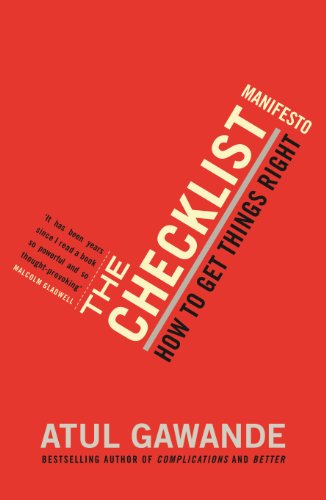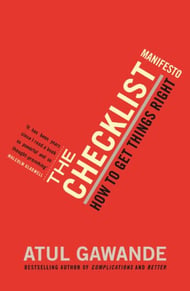The why, how, what and who of sales checklists
October 30, 2019

 When Harvard Medical School Professor (and BBC Reith Lecturer) Atul Gawande published his “Checklist Manifesto” nearly 10 years ago, it soon became apparent that the application of simple checklists - which have transformed patient outcomes in healthcare systems around the world in recent years - had implications far beyond the world of medicine or aviation.
When Harvard Medical School Professor (and BBC Reith Lecturer) Atul Gawande published his “Checklist Manifesto” nearly 10 years ago, it soon became apparent that the application of simple checklists - which have transformed patient outcomes in healthcare systems around the world in recent years - had implications far beyond the world of medicine or aviation.
There are many parallels between the worlds of medicine and sales, not least of which the idea that both surgeons and salespeople often tend to have a very high regard for their personal capabilities and a natural distaste for working within what they see as over-rigid systems that prevent them from practising their craft.
Checklists have been recognised as essential contributors to aviation safety for decades. But it turns out that the disciplined application of checklists in sales and medicine also have profound benefits for everyone concerned - for both the practitioners and the patients (or customers in a sales environment) ...
My colleague George Brontén of Membrain has developed a CRM solution that makes it particularly straightforward to guide winning sales behaviours through the intelligent application of checklists and he - like me - has been an enthusiastic promoter of the concept.
But it would be wrong to think of checklists as no more than simple tick boxes, even if that’s the way that - at face - value they are implemented in a CRM platform. Without context, even well-chosen checklists can become an exercise in completion rather than contemplation. And it’s the thinking behind the checklist items that turn out to be really important.
That’s what I mean by the why, how, what and who of sales checklists
Start with why
There’s little value in defining a checklist item if the person who is expected to complete the task does not understand the context. Without clear context, a checklist can descend into a thoughtless mechanical box-ticking exercise.
Before you can expect a person to complete a task, you need to ensure that they understand and buy-in to why that task needs to be completed, why it benefits them, and what would happen if the task was rushed or skipped.
Explain how
Good checklists - and good checklist items - are simple. But that doesn’t mean that how to complete them properly is always obvious or automatic. So, as well as reminding your user of what they need to do, you need to ensure that they know how to complete the task most effectively.
You may want to publish simple guidelines, show examples of well-completed tasks, or use short instructional videos to educate and remind them.
Clarify what
The best checklist items are (to quote Einstein) as simple as possible, but no simpler. Ambiguous items tend to not get completed properly. Over-complicated items may encourage the user to skip them.
You may find it necessary to break down an otherwise complicated task into a handful of simple-to-understand, easy-to-implement sub-tasks - but be careful to focus on the critical elements.
Identify who
Actions need owners. But Gawande stressed the importance of communication and collective responsibility. Having your salespeople complete the checklist on their own in glorious isolation is far less effective than getting them to review the particularly important steps with their managers and colleagues.
Certain straightforward checklist items, for example, might be classified as “implement then record” and other more complex or nuanced items might be classified as “review with [name] before completing”.
Never a tick-box exercise
Sales checklists have the potential to be an incredibly powerful tool. But if they are to be effective in driving the appropriate actions and behaviours, they must never be seen as merely “tick-box” exercises.
When they are used to guide salespeople in how (and why) they need to think, as well as in what they need to do, they can have the same dramatic impact on improving sales outcomes as medical checklists are having in dramatically transforming patient outcomes.
If you’re interested in learning more about how to apply the discipline of checklists in your own sales organisation, I strongly recommend you read Gawande’s book, take a look at the value selling edition of Membrain’s excellent CRM platform - and book a call with me to discuss the concept.
ABOUT THE AUTHOR
 Bob Apollo is a Fellow of the Association of Professional Sales, a member of the Sales Enablement Society, a founding contributor to the International Journal of Sales Transformation, a member of the Sales Experts Channel and the driving force behind Inflexion-Point Strategy Partners, the leading UK-based B2B value-selling experts.
Bob Apollo is a Fellow of the Association of Professional Sales, a member of the Sales Enablement Society, a founding contributor to the International Journal of Sales Transformation, a member of the Sales Experts Channel and the driving force behind Inflexion-Point Strategy Partners, the leading UK-based B2B value-selling experts.
Following a successful corporate career spanning start-ups, scale-ups and market leaders, Bob now works as a strategic advisor, mentor, trainer and coach to ambitious B2B sales organisations - equipping them to create, confirm and communicate their unique business value in complex sales situations.


Comments